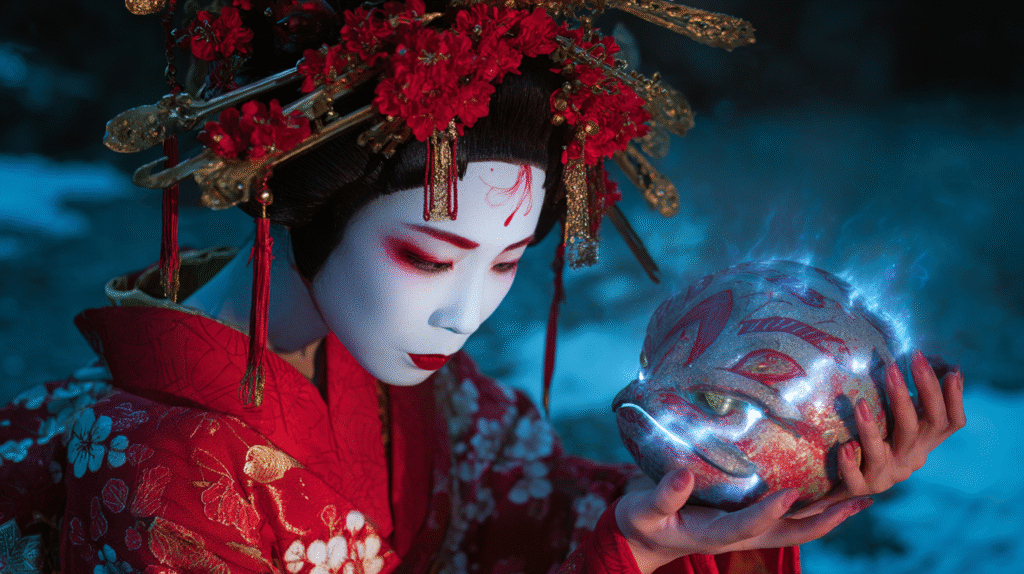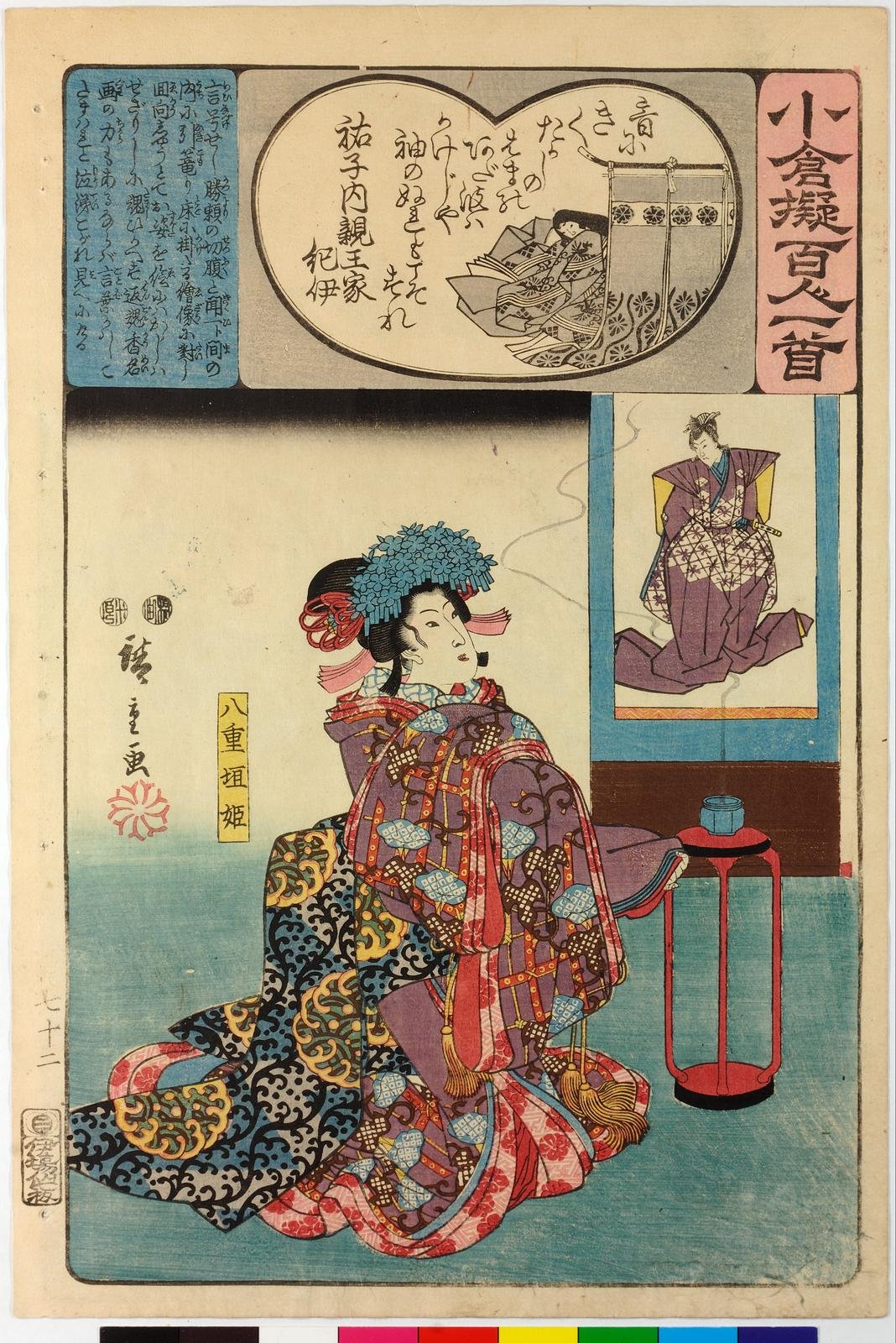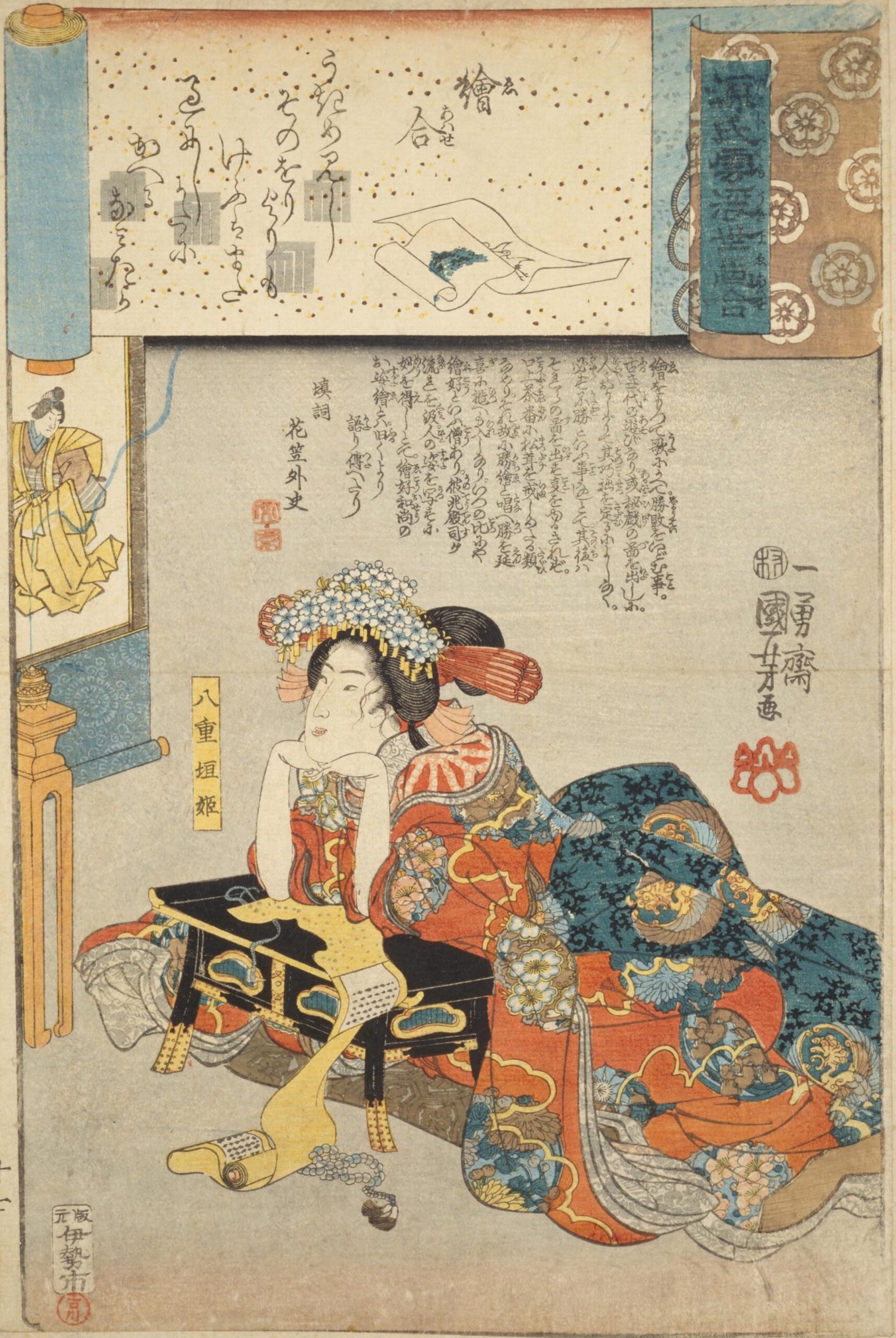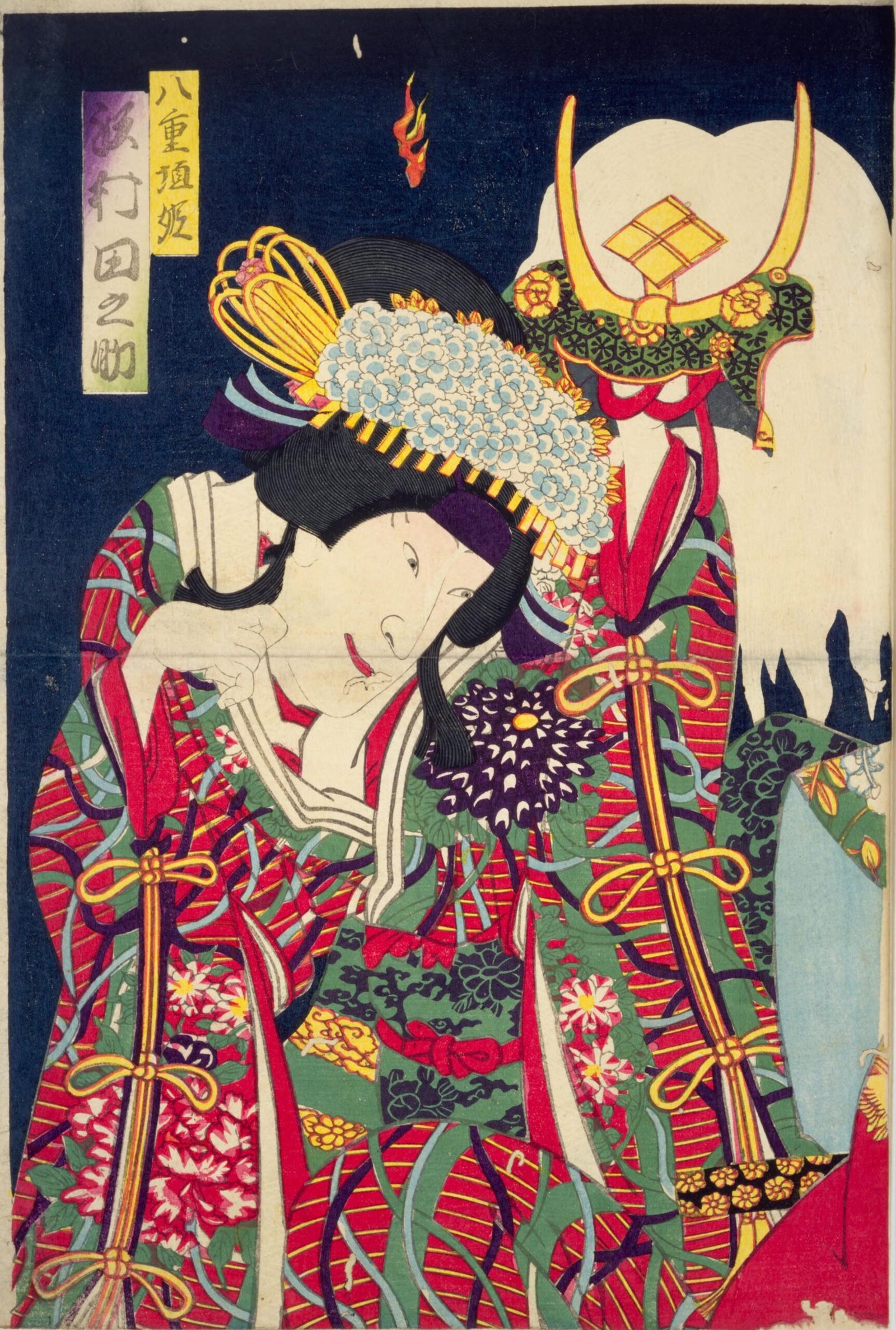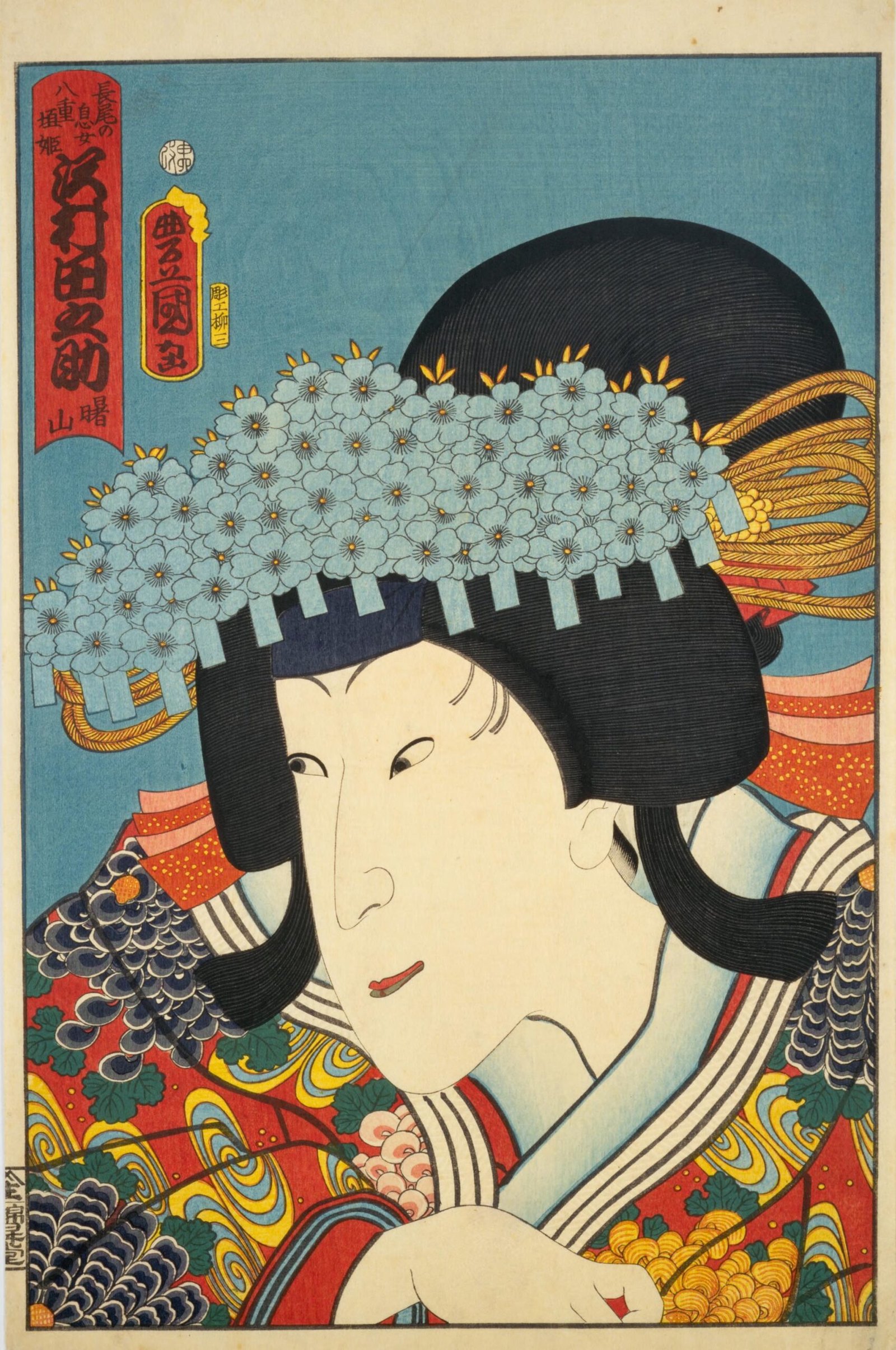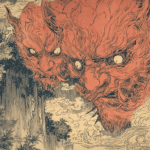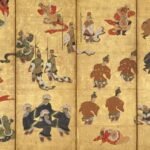When browsing through collections of ukiyo-e woodblock prints, one often encounters the graceful figure of a princess adorned in brilliant red kimono. This recurring image most likely depicts Yaegaki-hime, a fictional character who has captivated audiences in the kabuki theater world for centuries. But who exactly is this princess who fascinated Edo period audiences and continues to mesmerize viewers today?
The Birth of Yaegaki-hime: Premier Princess of Kabuki’s “Three Princesses”
Yaegaki-hime first appeared in the puppet theater (bunraku) play “Honchō Nijūshikō” (The Twenty-Four Filial Exemplars of Japan), which premiered in 1766. The work was a collaborative effort led by Chikamatsu Hanji, adapting the Chinese tales of filial piety into a Japanese Warring States period setting. This creative transformation gave birth to one of kabuki’s most enduring characters.
In the kabuki world, Yaegaki-hime holds a distinguished position as one of the “Three Princesses” (san-hime), alongside Yuki-hime from “Gion Sairei Shinkōki” and Toki-hime from “Kamakura Sandaiki.” These three roles are collectively known as “akahime” (red princesses), characterized by their scarlet costumes symbolizing youth, beauty, and noble birth. Among these prestigious roles, Yaegaki-hime stands out for her dramatic storyline and the exceptional acting skills required to portray her, making this one of the most challenging and coveted roles for onnagata (male actors specializing in female roles).
A Tale of Pure Love Defying Destiny
The story unfolds during Japan’s Sengoku period (1467-1615), when powerful warlords vied for control of the country. Yaegaki-hime appears as the daughter of Nagao Kenshin (later known as Uesugi Kenshin), the legendary daimyo of Echigo Province. While historically Kenshin remained celibate throughout his life, making the existence of a daughter impossible, this creative liberty serves the dramatic narrative perfectly.
To establish peace between the warring Takeda and Nagao clans, Yaegaki-hime is betrothed to Takeda Katsuyori, son of the famous Takeda Shingen. However, when Shogun Ashikaga Yoshiharu is mysteriously assassinated (historically, he died of illness), both clans are ordered to find the culprit within three years or sacrifice their heirs. Unable to identify the assassin, Katsuyori appears to commit ritual suicide (seppuku).
The plot takes a dramatic turn when it’s revealed that the dead man was actually a body double. The real Katsuyori has infiltrated the Nagao household disguised as a gardener named Minosaku, intent on recovering the Takeda family treasure: the mystical helmet of Suwa Hōshō, blessed by the deity of Suwa Shrine.
The Miracle Illuminated by Fox Fire
The climax of Yaegaki-hime’s story showcases the fantastical elements that make Japanese traditional performing arts so unique. When the princess discovers that her father Kenshin plans to assassinate Katsuyori, her desperation to save her beloved drives her to pray before the sacred helmet.
In response to her pure-hearted plea, the spirit of a white fox—messenger of the Suwa deity—possesses the princess. Empowered by this supernatural force, Yaegaki-hime performs the impossible: she crosses the frozen surface of Lake Suwa to warn Katsuyori of the impending danger. This scene, known as “Okniwa” (The Inner Garden), represents one of kabuki’s most visually stunning and emotionally powerful moments.
Yaegaki-hime Through the Eyes of Ukiyo-e Masters
The dramatic story and visual splendor of Yaegaki-hime captivated Edo period ukiyo-e artists, who created numerous interpretations of this beloved character.
Utagawa Kuniyoshi’s “Ogura Nazorae Hyakunin Isshu” demonstrates remarkable creativity by connecting Yaegaki-hime with the classical poetry anthology “Hyakunin Isshu” (One Hundred Poets, One Poem Each). In another work, “Genji-gumo Ukiyo-e Awase,” Kuniyoshi skillfully parallels the princess with scenes from “The Tale of Genji,” Japan’s eleventh-century literary masterpiece, showcasing the sophisticated cultural knowledge expected of both artists and their audience.
Toyohara Kunichika’s prints often depicted specific actors in the role, such as the fourth-generation Sawamura Tanosuke, providing valuable documentation of kabuki performances and the popularity of certain actors. These works highlight the distinctive visual elements that define Yaegaki-hime: the crimson furisode (long-sleeved kimono), the elaborate uchikake (outer robe), and the characteristic “fukiwa” hairstyle that marks her as a noble princess.
The prolific Utagawa Kunisada (later known as Toyokuni III) created multiple compositions featuring not only Yaegaki-hime but also other characters from the play, including Katsuyori and the maid Nureginu, helping viewers understand the complex relationships within the story.
The Japanese Aesthetic Embodied
The tale of Yaegaki-hime crystallizes essential elements of Japanese aesthetics and cultural values. The narrative weaves together forbidden love across social boundaries, self-sacrificing devotion, and miraculous intervention—themes that exemplify the interplay between reality and fantasy characteristic of Japanese traditional performing arts.
The symbolism of the color red deserves special attention. In Japanese culture, red represents youth, passion, and sacred power. Yaegaki-hime’s scarlet attire simultaneously expresses her pure love and her connection to divine forces. This color coding would have been immediately understood by Edo period audiences and continues to resonate with modern viewers.
The crucial role of the fox in the story reflects deep-rooted Japanese spiritual beliefs. In Shinto tradition, foxes serve as messengers of Inari, the deity of rice and prosperity. They are also shape-shifters (bakemono) capable of possession and transformation. Without understanding this cultural context, the miraculous crossing of Lake Suwa might seem merely fantastical rather than spiritually significant.
Yaegaki-hime in the Modern Era
More than 260 years after her creation, Yaegaki-hime continues to grace kabuki stages across Japan. This endurance speaks not merely to cultural preservation but to the timeless themes that resonate across generations and cultures.
The princess embodies universal human experiences: pure love, courage in the face of adversity, and the willingness to sacrifice everything for those we cherish. These themes transcend temporal and cultural boundaries, touching hearts regardless of nationality or era. The numerous ukiyo-e prints depicting Yaegaki-hime serve as testament to how deeply Edo period audiences connected with her story.
The Competition Among Ukiyo-e Artists
For Edo period ukiyo-e artists, Yaegaki-hime represented an ideal subject. Beyond the popularity of the kabuki play itself, the visual appeal of a beautiful princess inspired creative competition among artists.
Each artist brought unique interpretation and technique to their depictions. Utagawa Kuniyoshi’s “Edo-nishiki Imayō Kunizukushi” presents Yaegaki-hime as a symbol of Shinano Province, demonstrating intellectual playfulness that connects geographic knowledge with the story’s setting. Similarly, Kōchōrō Toyokuni’s “Dai Nippon Rokujūyoshū no Uchi” links the princess with Kai Province (modern Yamanashi Prefecture), alluding to her deep connection with the Takeda clan based there.
These artistic choices reveal how ukiyo-e transcended mere illustration, becoming a sophisticated medium for cultural commentary and intellectual engagement.
The Marriage of Theater and Visual Art
Ukiyo-e depictions of Yaegaki-hime illuminate the symbiotic relationship between kabuki theater and woodblock print art. Artists attended performances, carefully observing actors’ movements, gestures, and costume details to achieve accuracy in their prints.
Yet ukiyo-e was never merely documentary. Artists infused their works with psychological depth and symbolic meaning impossible to convey on stage. Prints showing Yaegaki-hime embracing the sacred helmet employ composition and color to suggest the artifact’s mystical power, adding layers of meaning beyond theatrical representation.
Conclusion: The Eternally Blooming Eight-Fold Princess
The name Yaegaki-hime itself carries symbolic weight—”yae” means “eight-fold” or “many layers,” while “gaki” means “fence” or “barrier.” Thus, her name suggests a princess who overcomes multiple obstacles. These barriers include social class differences, clan rivalries, and physical distance—all conquered through love’s transformative power. This image continues to move audiences across centuries.
The ukiyo-e prints depicting Yaegaki-hime represent far more than beautiful portraits. They visualize one of Japanese traditional theater’s most beautiful and dramatic narratives. The image of the princess in her red furisode, clutching the sacred helmet of Suwa Hōshō, eternally proclaims love’s strength and beauty.
When next visiting an ukiyo-e collection or museum, seek out works featuring Yaegaki-hime. Within these prints lives the beauty and emotion felt by Japanese audiences over 260 years ago, preserved in unfading color and line, waiting to touch modern hearts with their timeless message of love triumphant.
References:
- Cultural Digital Library: Yaegaki-hime
- Introduction to Kabuki – Character Roles and Actors: Yaegaki-hime
- National Diet Library Digital Collection: Yaegaki-Hime
More Ukiyo-e prints of Yaegaki-Hime (Public Domain):
- Ogura Nazorae Hyakunin Isshu (Hiroshige Kuniyoshi)
- Genji-gumo Ukiyo-e Awase (Ichiyūsai Kuniyoshi)
- Takeda Katsuyori & Yaegaki-hime (Toyohara Kunichika)
- Princess Yaegaki-hime, Daughter of Nagao (Toyokuni)
- Yaegaki-hime, Takeda Katsuyori & Nureginu (Toyokuni)
- Yaegaki-hime, Takeda Katsuyori & Nureginu (Ichiyōsai Toyokuni & Kōchōrō Toyokuni)
- Dai Nippon Rokujūyoshū no Uchi: Kai (Kōchōrō Toyokuni) – Museum of Fine Arts, Boston
- Hida no Takumi & Yaegaki-hime (Ichiyūsai Kuniyoshi)
Editorial Notes
- Due to the specialized nature of kabuki theater, many source materials contain archaic Japanese language. We have utilized AI-assisted translation for reference purposes. Should you notice any inaccuracies or errors, please feel free to contact us.
- The photographic images in this article were created using Midjourney, depicting scenes as envisioned by the Zenchantique editorial team.
- All ukiyo-e prints featured are from public domain collections. Clicking on any print will direct you to its original source.
- For those interested in discovering more hidden stories within ukiyo-e prints, explore our complete collection under the tag [Ukiyo-e Stories Series].

